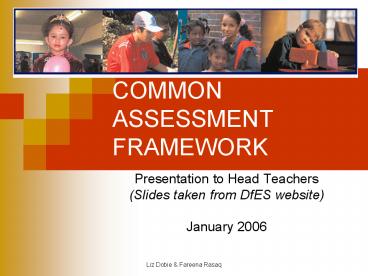COMMON ASSESSMENT FRAMEWORK - PowerPoint PPT Presentation
1 / 10
Title:
COMMON ASSESSMENT FRAMEWORK
Description:
Enables and encourages information held by agencies to follow the child ... Childcare. Early years. Social care. Police and Youth justice. Liz Dobie & Fareena Rasaq ... – PowerPoint PPT presentation
Number of Views:126
Avg rating:3.0/5.0
Title: COMMON ASSESSMENT FRAMEWORK
1
COMMON ASSESSMENT FRAMEWORK
- Presentation to Head Teachers
- (Slides taken from DfES website)
- January 2006
2
What is the CAF ?
- A national, more standardised approach to
assessing childrens needs for services and how
they should be met - A means to support earlier identification and
intervention by enabling practitioners in
universal, as well as targeted or specialist
services, to assess needs at an early stage - For use by practitioners in all agencies so they
can communicate more effectively, supporting
inter-agency referral and multi-agency working - Potentially the main method whereby needs are
assessed by agencies, reducing the number and
scale of specialist assessments - A supportive process not a form filling exercise
Where coordinated support is required from more
than one agency a Lead Professional will be
chosen Completion of a common assessment is
not a guarantee that services will be delivered
3
The aims of the CAF
- Provide a method of assessment to support earlier
intervention - Improve joint working and communication by
helping to embed a common language - Improve the coordination and consistency between
assessments - Inform whether further specialist assessment is
necessary - Enable a picture needs to be built up over time
and, with appropriate consent, shared among
professionals. - Provide better, more evidence-based referrals
4
The principles underpinning common assessment
- Looks at the whole child /young person
- Takes account of strengths as well as needs
- Is simple to use
- Is empowering
- Enables and encourages information held by
agencies to follow the child - Is a tool to support practice
5
Content of the CAF
6
When to do a common assessment
- A common assessment should be completed when it
will help the child/young person to achieve one
or more of the ECM five priority outcomes. This
decision is likely to require professional
judgement in the light of local policy practice - CAF can be used with any unborn baby, new baby,
child or young person who has additional, unmet
needs but does not need to be done with
everyone - Follow ACPC/LSCB procedures where appropriate
- Common assessment is likely to be of help when
- Age appropriate progress is not being made and
causes are unclear - The support of more than one agency is needed
- Common assessment need not be done where
- Progress is satisfactory
- Needs are already identified and are being met
- Needs are clear and can be met by the family or
by the assessing agency
7
Who will use the CAF?
- Every practitioner should
- Be able to recognise and respond to key signs of
need - Know the CAF basics
- Know how to have a common assessment completed or
how to complete one - Every agency will train some staff to complete
common assessments - Where more than one practitioner is involved, one
will take the lead
- Agencies (statutory, community or voluntary
sector) include - Health
- Education
- Connexions
- Childcare
- Early years
- Social care
- Police and Youth justice
8
CAF as part of an effective case working process
Child/young person identified as potentially
having additional needs (by them, their family or
a practitioner), eg, through CAF checklist
Gathering and analysing information on strengths
and needs, eg, using common assessment
Child or Young person
Ongoing monitoring and review by those in contact
with the child
Determining and delivering interventions to meet
identified needs single agency or multi-agency
response
9
CAF and other assessments
- CAF will be adopted by all agencies
- Need can be identified through common assessment.
This may sometimes mean a specialist assessment
is not needed - CAF cannot replace specialist assessments
- CAF cannot replace the local child protection
process - There is ongoing consultation to determine how
other assessments should fit with the CAF
10
CAF as part of Integrated Working
Lead Professionals































